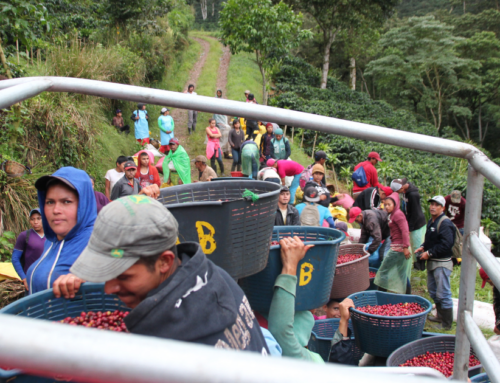With around three to four months left until the start of the new harvest, this Papua New Guinea green coffee origin update comes at an excellent time for Genuine Origin and roasters who are planning their 2022 schedules. Our sister company, Volcafe PNG, shares with us how the country is handling COVID-19 and the recent C-market price fluctuations while bringing us closer to the unique situation behind PNG’s relationship with coffee as a cash crop commodity.
When it comes to coffee, the island country of Papua New Guinea (PNG) is a green coffee origin that goes against the grain. If you’ve been keeping up with Genuine Origin’s origin reports from countries like Costa Rica and Tanzania, you might have noticed a trend among our producing partners who increasingly embrace coffee farming as a business. In PNG, however, coffee balances on an unusual position: on the one hand, it’s an essential export commodity for the country’s economy; on the other hand, coffee crops receive little to no investment from smallholder farmers.
Out of the nine million people in PNG, around 2.5 million (30%) are involved in coffee. Exports of coffee account for approximately 6% (US$72 million) of the country’s GDP, and it’s the second leading agricultural product after palm oil. With numbers like that, most people expect coffee to be highly valued locally, but production levels tell a different story. Over the past decade, coffee volume has steadily declined in PNG due to unique geographic and cultural challenges rarely seen in other origin countries.
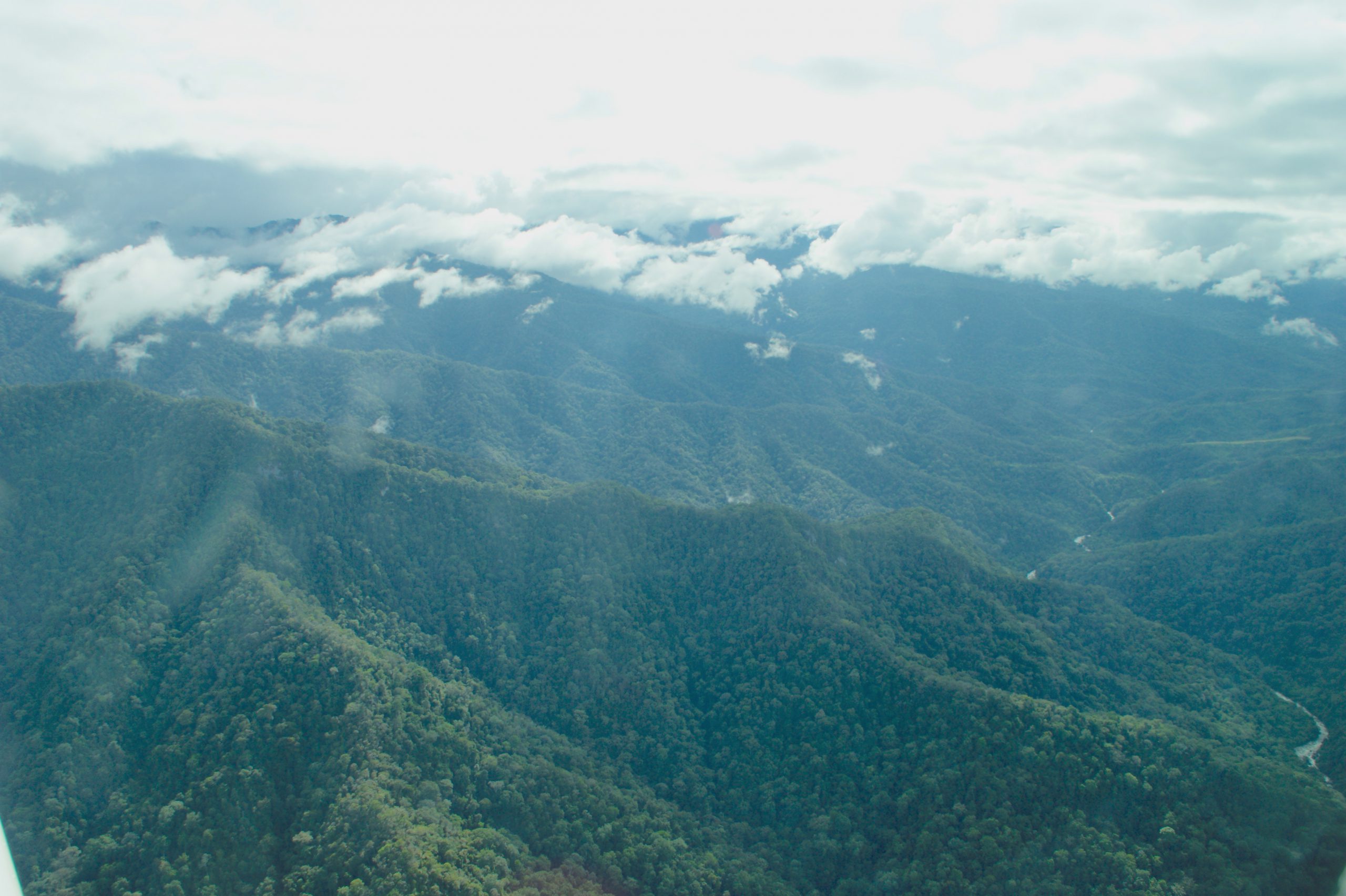
PNG coffees mountainous terrain
It takes serious incentive to get a farmer to bring a bag of his backyard-grown coffee to market because the infrastructure in PNG is so poor. Rural farmers face a 3–7-day walk carrying their coffee until they reach a road. From there, vehicles charge fees to bring the coffee to the nearest village before it makes its way to a bigger town until it finally arrives at a coffee market.
With coffee prices where they are now, it might be worth the effort. But in the years leading up to the pandemic, coffee prices were much less attractive to these rural farmers, and their coffee gardens were left to overgrow untended. “They don’t live for the money they generate from growing coffee,” explains Sunil Machiah, General Manager of Volcafe PNG, Genuine Origin’s sister company. “The people in PNG [already] have what we try to achieve at the end of our careers: the bond with the land. They have a roof over their heads, grow their own food, and live off the land. They’re not economically wealthy, but no one is poor, and no one starves,” he adds.
Sunil explains that the coffee trees growing in their backyards are more like ATMs than a requirement for sustenance. “When farmers need some money [for school fees or other expenses], they’ll pick the cherries. Otherwise, they aren’t too worried if the cherries fall off the trees,” he says.
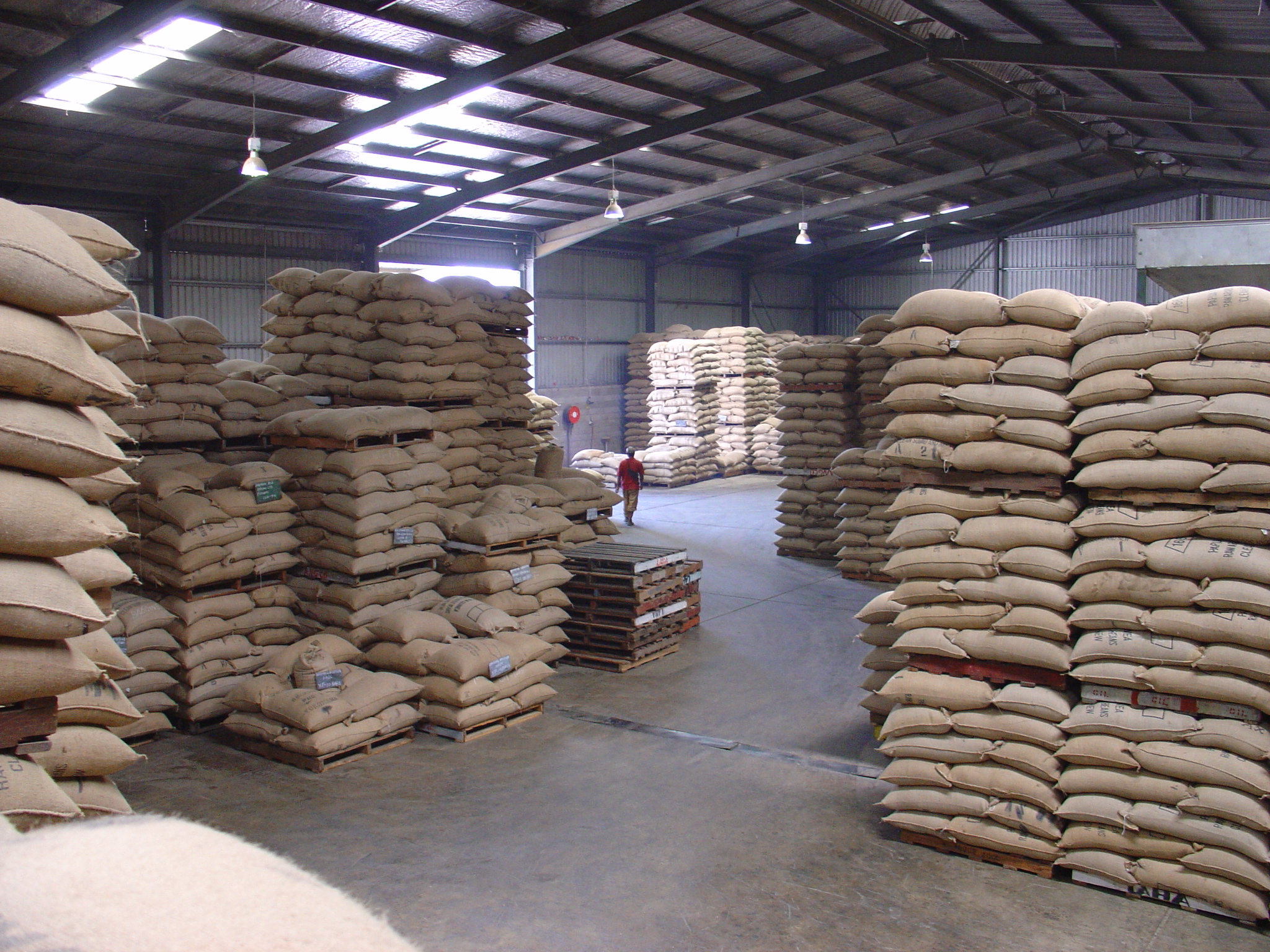
Volcafe PNG Green Coffee Warehouse
Volcafe PNG
Today, Volcafe PNG is the oldest and largest exporter serving the country since the company’s inception as PNG Coffee Exports Ltd. in 1979. Over the last 40 years, Volcafe PNG has seen coffee supply dwindle while the number of available exporters has grown. “Once, we had seven exporters buying one million bags. Today we have 20 exporters buying 700-800,000 bags,” says Sunil. However, Volcafe PNG has been able to turn the situation to their advantage.
Premiumization came about almost by default in PNG. While Volcafe PNG was offering higher prices to buy a smaller supply of coffee, they were also raising their quality standards to justify those prices. In the past, 60-70% of Volcafe PNG’s exports were at the Y1 grade. Now, PSC-grade* coffee has taken over at 60% of the total volume, and Volcafe PNG is still ramping up efforts to improve quality at the processing and export stages of the supply chain.
The company’s dry mill at Lahamenegu is the largest in the country. Volcafe PNG recently completed a two-year, million-dollar renovation to improve machinery and take on additional volume to put through a better product. In the future, dry milling will be centralized in Lahamenegu to process 180,000 bags of PNG green coffee each year.
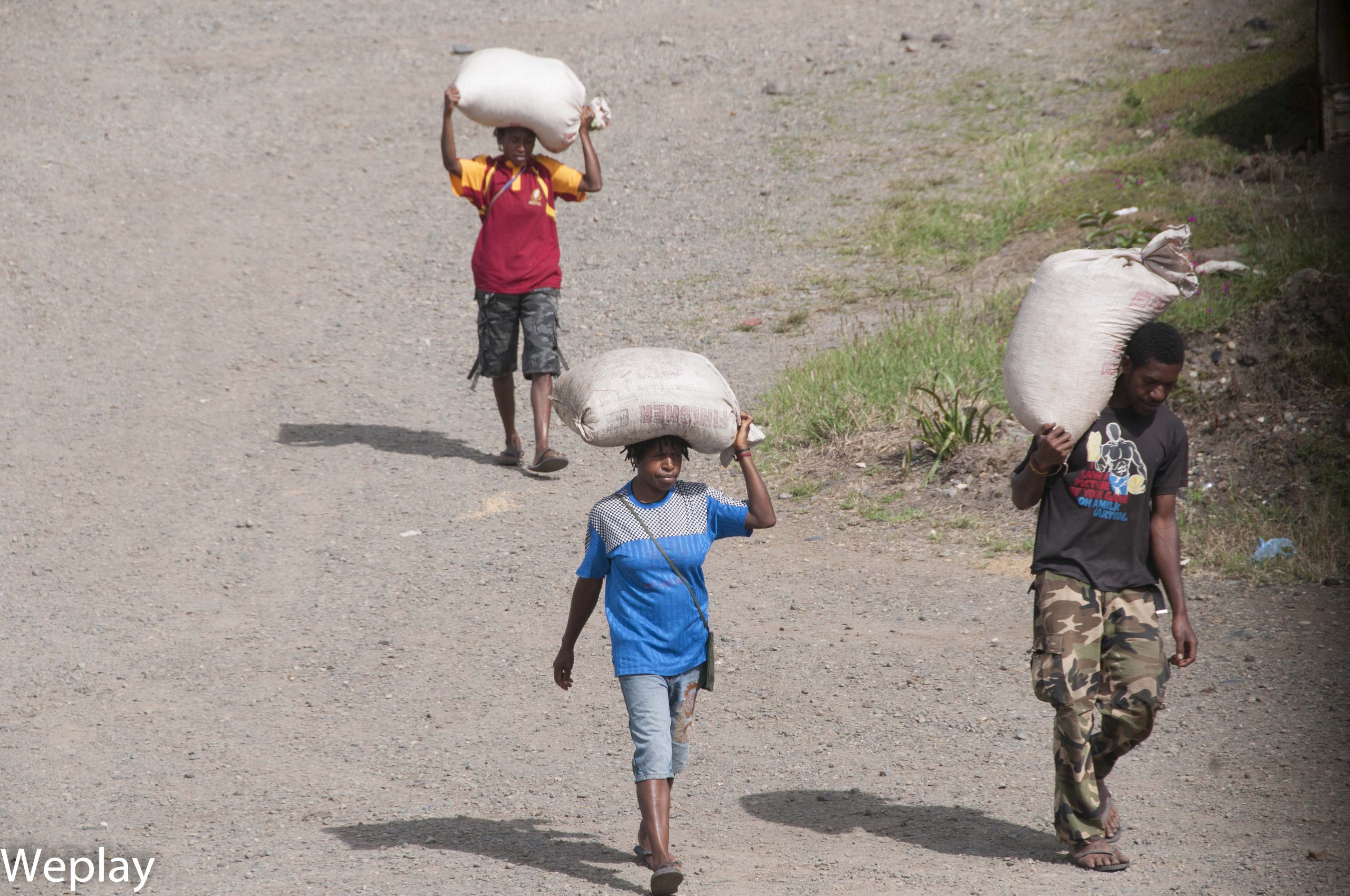
Walking coffee to market in PNG
Country-wide Production of PNG Specialty Coffee
Commercial coffee production took off in the 1920s on large European- or Australian-owned estates, beginning with the Blue Mountain variety from Jamaica. The bulk of PNG’s coffee volume comes from the Western Highlands, Eastern Highlands, Morobe, Simbu, and Jiwaka provinces. The diversity across these regions is fascinating, not only in coffee production but also in cultural heterogeneity. Over 820 distinct languages are spoken in PNG, with each village following its own customs and cultural expression. These distinctions unsurprisingly make it challenging to organize smallholders into cooperatives.
When PNG gained independence from Australia in 1975, large pieces of plantation land were broken into blocks and given back to landowners. The tribal lands are continuously subdivided with each generation as fathers pass ownership to their children, which is why over 80% of PNG’s coffee comes from smallholder farmers.
The main harvest in this green coffee origin is from May to September, with volume cycling between one “on” year and one “off” year and a larger harvest every five years. “Our team on the ground is feeding visuals and information to our research team in India from their visits to sample farms,” says Sunil. “Based on what we’ve seen between the blossoming and ripening stage, the 2021/2022 crop is looking really good, which is odd because in my 26 years at Volcafe PNG, it’s the first time I’ve seen two good years, one after the other.”
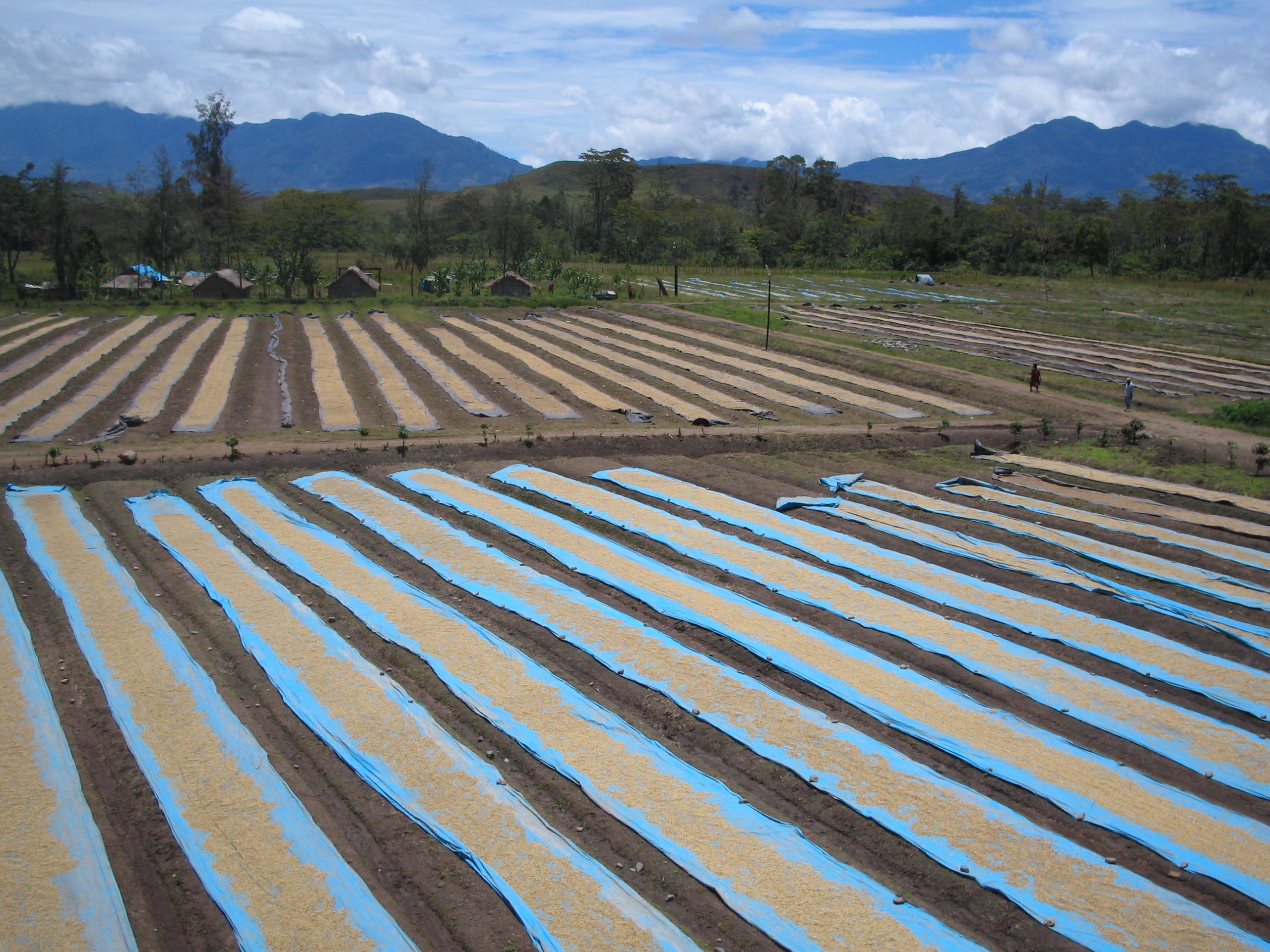
PNG Green coffee drying
Growing & Processing More Specialty Green Coffee
Volcafe PNG is the only exporter to own a wet mill in PNG. The Lahamenegu wet mill in the Eastern Highlands is equipped with brand new machinery to take PNG cherries to the next level in quality control. While most smallholders wash and process coffee themselves and bring parchment to market, Volcafe PNG has the capability to buy in cherry and control processing consistency.
What’s even more exciting is that private ownership of a wet mill allows Volcafe PNG to experiment with other processing methods rarely on offer for PNG coffee, like the Lahamenegu Red Mountain Natural, which was exceedingly well-received by roasters in the US. (The first batch sold out within days.
“Because we have our own wet mill, we can use the extra time to experiment with naturals. Other wet mill operators would not be willing to do this for us because it ties up their drying fields for weeks,” says Sunil. As Volcafe PNG continues to experiment with new lots of naturals and even honeys, roaster reception and demand will dictate whether they invest in more infrastructure focused on improving quality in this processing direction.
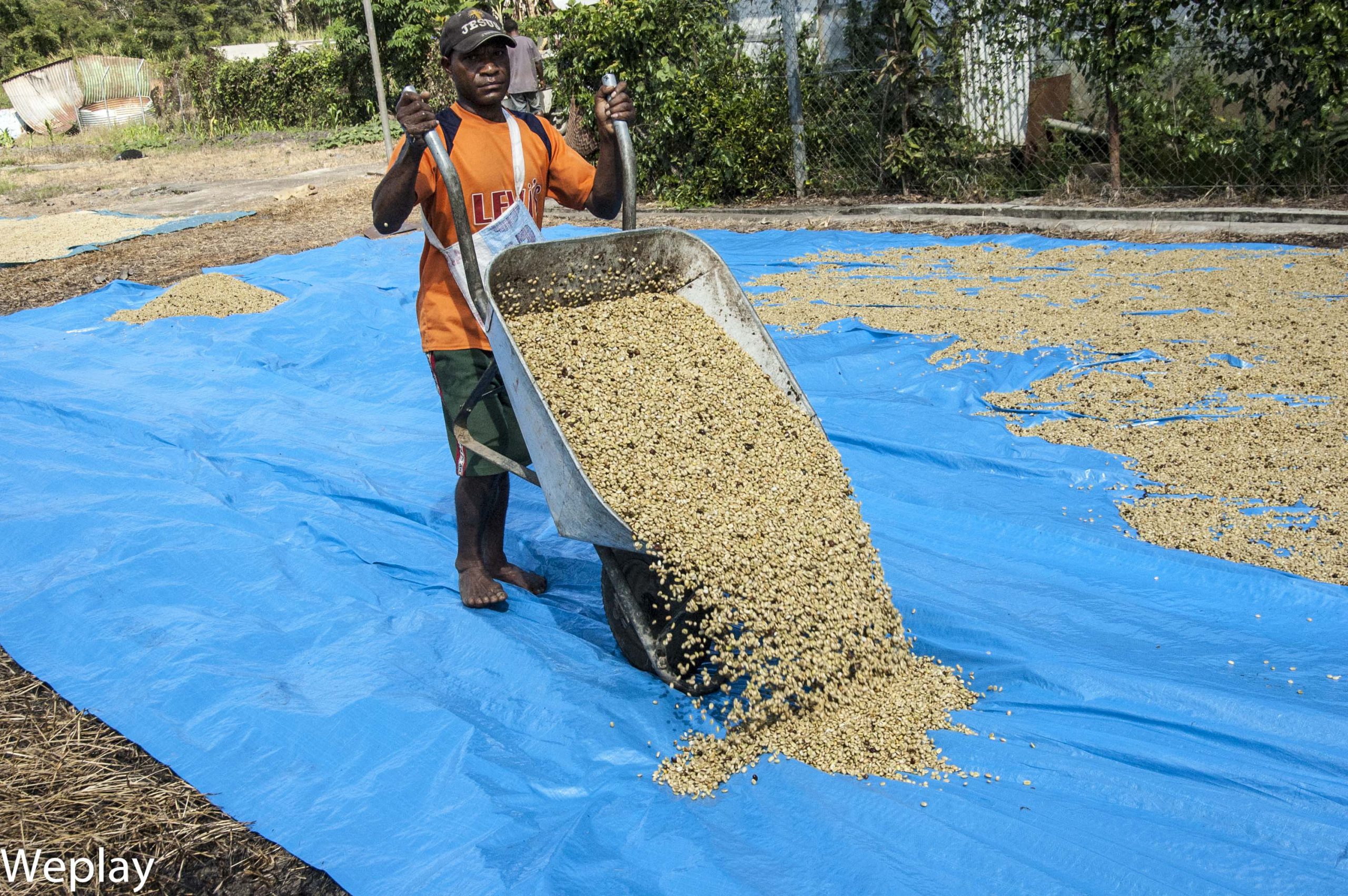
Sun drying green coffee at Lamanegu mill in PNG
The Volcafe Way sustainability approach currently has a limited presence in PNG, and efforts are primarily centered around the supply chain at the Lahamenegu wet mill. With the help of buyers who source cherry on Volcafe PNG’s behalf daily, they can process the coffee at the mill for maximum quality. Plantation-grade coffee is also managed from cherry through to green bean and results in the most consistency out of all the grades.
Encouraging farming as a business in PNG is challenging because farmers are not commercial-minded or long-term planners. “There’s a very different thinking culture in this country. For example, when we give out free seedlings from our nursery, we visit the farmer a month later, and the seedlings are dead in the corner of their house because it’s of no value to them,” shares Sunil. “If we charge a price for the seedling, they might see the benefit of it, but if you give it to them free of cost, they’re not going to plant it.” There is tremendous potential for PNG to soar from where it is now in terms of flavor profile and agronomic improvements as a green coffee origin. The challenge is getting the farmers on board.
Coffee in PNG is currently completely weather-dependent and the “on” and “off” years dictate the crop in the country. On the smallholder level, investing in fertilizer is practically inconceivable, which results in almost all the coffee being grown organically. While certifications are a costly investment, Volcafe PNG is meeting the demand for Fairtrade Organic coffee with certified supply from farmers who sell coffee in parchment.
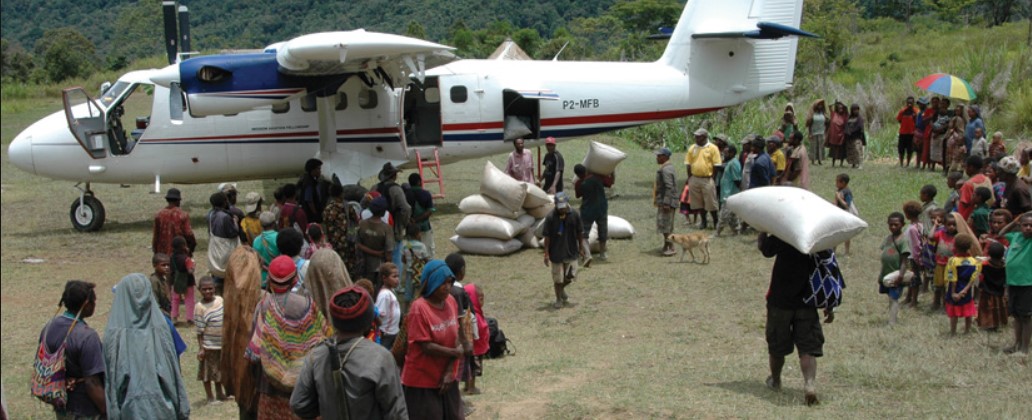
Green coffee being airlifted in Simbai Province
Overcoming the Challenges of Bringing PNG Specialty Coffee to Market
Communities in PNG are still incredibly remote and unreachable. While every other producing green coffee origin transports coffee on land, PNG specialty coffee from regions like Simbai must be airlifted to reach the market.
Volcafe PNG works with American aviation companies that serve rural areas with religious ministrations, trade goods, or passenger transport. “They fly out to these remote airstrips to translate the bible or service the area with goods and bring coffee back in. It serves a great purpose for these farmers,” says Sunil. Over 4,000 farmers in Simbai have access to storage sheds at these airstrips where parchment is weighed and recorded. Then, when there is enough for a planeload, Volcafe PNG readies a charter flight to bring the coffee to Mt Hagen for further processing.
The past few decades have been a quantum leap from the stone age into the nuclear age for people in PNG, and the effects of technology are still barely scratching the surface for PNG’s potential.
Twenty-five years ago, farmers who made the multi-day trek to bring their coffee to market were often forced to sell at whatever price was offered on the day because they couldn’t afford to sit around and negotiate a better deal. Today, they can call ahead and check the price before leaving the village. It’s a small but significant advance that moves the trade more to their advantage, especially when prices are as volatile as they are now.
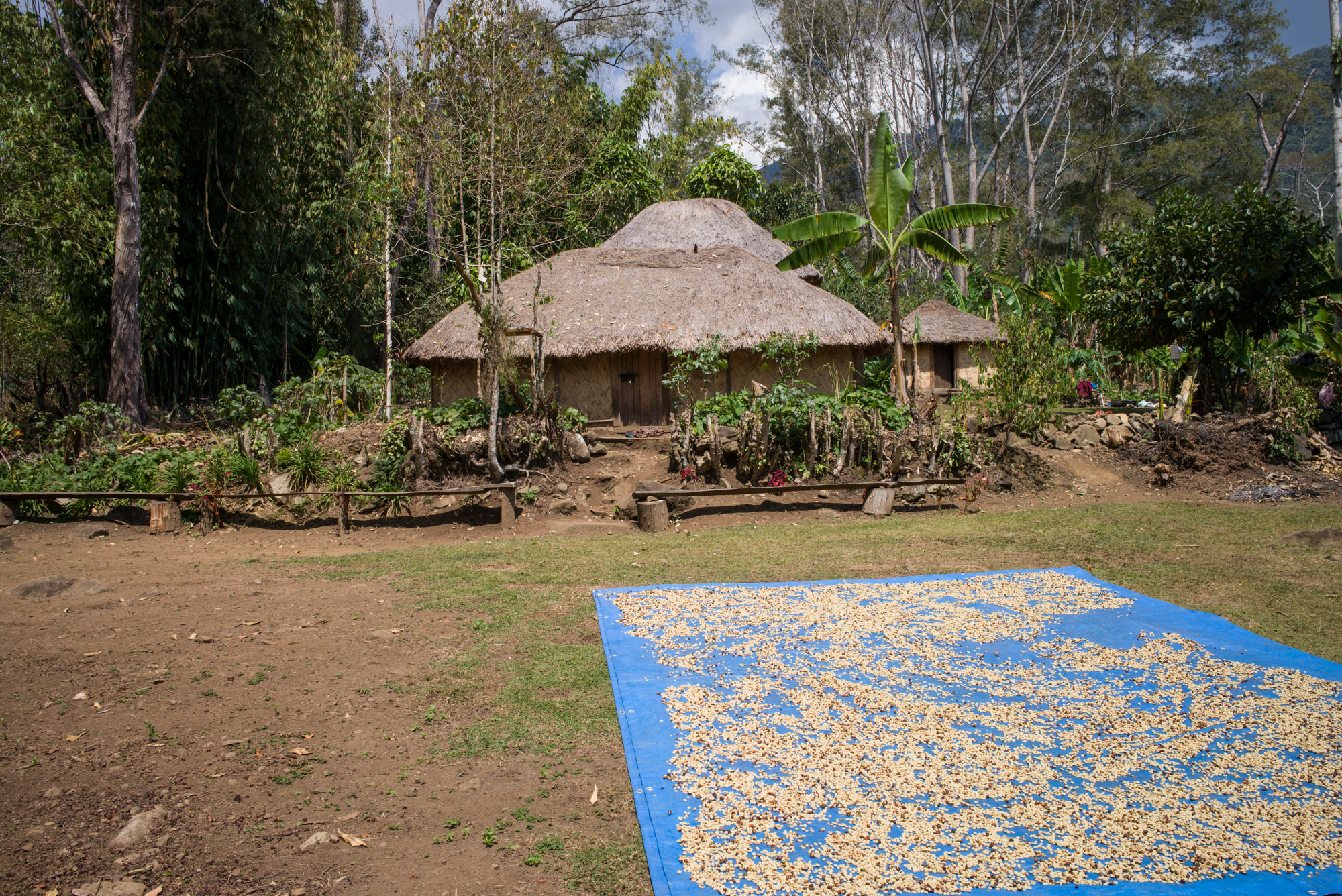
Smallholder drying coffee in PNG
However, the extent to which farmers in PNG follow the market stops there. A lack of long-term vision makes it difficult to increase coffee production year on year because farmers often don’t see beyond the immediate benefit of selling coffee at their convenience. While producers in other origin countries see the market trend as an opportunity to ramp up production now for further profits down the line, farmers in PNG are not interested in planting more trees or setting up a pruning schedule for the chance to earn more money in three years’ time.
Coffee Production & COVID
PNG is also in a bubble of its own regarding attitudes towards the pandemic and vaccinations. Due to strong religious beliefs that link sickness with weak spirituality and sorcery, there is a stigma attached to COVID-19. As a result, few patients are tested for the virus itself, leaving PNG blind and lacking data about actual infection and death rates from COVID-19.
Less than 4% of the adult population is vaccinated, instead choosing to trust in God and herbal medicines to protect them from illness. While the government implemented some travel restrictions between rural areas and town areas at the start of the pandemic from March to May 2020, the restrictions quickly ended, and life has resumed normally.
“While we maintain safe practices and social distancing at Volcafe PNG, working from home was never part of the PNG workforce. We’ve been working from the office the entire time, and there haven’t been any lockdowns or restrictions like what’s happening in the ‘real world,’” shares Sunil.
Although international travel remains closed to non-PNG citizens, Sunil estimates zero impact on the coffee supply chain even as the rest of the world struggles to manage logistics. “There are no dramas about the movement of coffee here. It’s an essential commodity, so there are no restrictions. Additionally, because PNG’s ratio of imports and exports is 70% to 30%, we’ve never had any shortage of equipment to send coffee out.”

Red cherry for natural processing
Genuine Origin and 2022 PNG Green Coffee
With a few months left to go until the new harvest, Volcafe PNG has been busy at work improving experimental processing methods in preparation for demand in 2022. After the first trials of natural PNG green coffee from the Lahamenegu wet mill sold out, Genuine Origin recalls the feedback received from roasters who were excited to try something new.
“People have said they needed to sort this coffee a lot, but the cup itself is great, and they’d even be willing to pay more for it if it was processed a bit better. Because we pack in smaller quantities, our customers are interested in things that are a little different and exciting,” says Jen Hurd, West Coast Sales Manager at Genuine Origin.
Sunil is excited to share what Volcafe PNG has been developing for natural PNG green coffee. “The quality and appearance are a lot better now. We’re still learning how to make a better product, and we’ve sun-dried cherries for over three weeks, slowly. We’re also trying to rest the coffee for 2-3 months to see if it makes a better cup,” he says.
At the same time, Volcafe PNG continues to source high-grade coffee from extraordinary places. The journey that Simbai Balus Kopi goes on to finally reach roasters in the US is an incredible one. After three years of offering this airlifted coffee, Genuine Origin is happy to see recognition and popularity grow with every lot that comes out of PNG.
“As long as we continue providing chartered flights and offering premium prices to Simbai farmers, we can have consistency in supply and cup profile. We hope that it will be a product we offer for as long as we operate here,” says Sunil. Each new lot of Simbai coffee sells out faster than the previous one, and Genuine Origin is delighted to bring roasters coffee from the remotest regions of the world through creative solutions by our partners on the ground.
Coffee production in PNG is as unique a story as they come. Greater variety and premiumization are two directions that have been well-received by roasters who buy PNG green coffee from Genuine Origin’s PNG portfolio, and there’s more of that to come soon in 2022.
*Earlier this year, the National Institute of Standards and Industrial Technology (NISIT) launched new standards for grading coffee from PNG to prevent price discrimination against smallholders and simplify grading categories. Previously, the top grade was only awarded to coffee grown on plantations, regardless of the quality level produced by a smallholder. The new Arabica grades are A, B, Y, Y2, and Y3, with grade B replacing the existing PSC grade.



